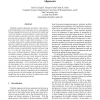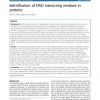315 search results - page 47 / 63 » Prediction of protein structural classes for low-homology se... |
SSDBM
2006
IEEE
14 years 1 months ago
2006
IEEE
Multiple sequence alignment represents a class of powerful bioinformatics tools with many uses in computational biology ranging from discovery of characteristic motifs and conserv...
NAR
2007
13 years 7 months ago
2007
The SUPERFAMILY database provides protein domain assignments, at the SCOP ‘superfamily’ level, for the predicted protein sequences in over 400 completed genomes. A superfamily...
BMCBI
2010
13 years 7 months ago
2010
Background: Small molecular cofactors or ligands play a crucial role in the proper functioning of cells. Accurate annotation of their target proteins and binding sites is required...
COMPLIFE
2005
Springer
14 years 1 months ago
2005
Springer
During the last few years new functionalities of RNA have been discovered, renewing the need for computational tools for their analysis. To this respect, multiple sequence alignmen...
BMCBI
2008
13 years 7 months ago
2008
Background: Non-homology based methods such as phylogenetic profiles are effective for predicting functional relationships between proteins with no considerable sequence or struct...


